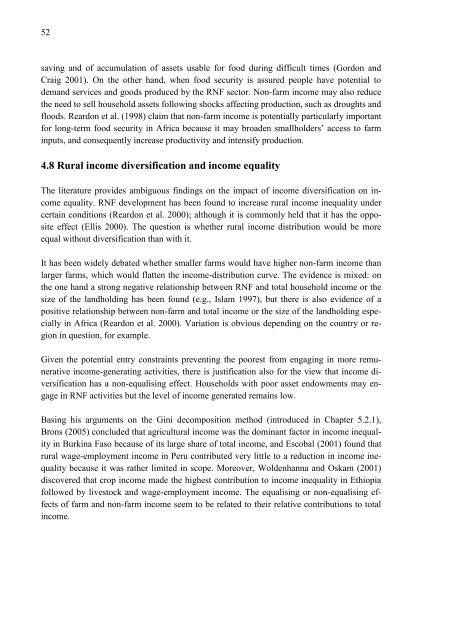Rural Income Generation and Diversification - A Case Study ... - Doria
Rural Income Generation and Diversification - A Case Study ... - Doria
Rural Income Generation and Diversification - A Case Study ... - Doria
You also want an ePaper? Increase the reach of your titles
YUMPU automatically turns print PDFs into web optimized ePapers that Google loves.
52<br />
saving <strong>and</strong> of accumulation of assets usable for food during difficult times (Gordon <strong>and</strong><br />
Craig 2001). On the other h<strong>and</strong>, when food security is assured people have potential to<br />
dem<strong>and</strong> services <strong>and</strong> goods produced by the RNF sector. Non-farm income may also reduce<br />
the need to sell household assets following shocks affecting production, such as droughts <strong>and</strong><br />
floods. Reardon et al. (1998) claim that non-farm income is potentially particularly important<br />
for long-term food security in Africa because it may broaden smallholders’ access to farm<br />
inputs, <strong>and</strong> consequently increase productivity <strong>and</strong> intensify production.<br />
4.8 <strong>Rural</strong> income diversification <strong>and</strong> income equality<br />
The literature provides ambiguous findings on the impact of income diversification on income<br />
equality. RNF development has been found to increase rural income inequality under<br />
certain conditions (Reardon et al. 2000); although it is commonly held that it has the opposite<br />
effect (Ellis 2000). The question is whether rural income distribution would be more<br />
equal without diversification than with it.<br />
It has been widely debated whether smaller farms would have higher non-farm income than<br />
larger farms, which would flatten the income-distribution curve. The evidence is mixed: on<br />
the one h<strong>and</strong> a strong negative relationship between RNF <strong>and</strong> total household income or the<br />
size of the l<strong>and</strong>holding has been found (e.g., Islam 1997), but there is also evidence of a<br />
positive relationship between non-farm <strong>and</strong> total income or the size of the l<strong>and</strong>holding especially<br />
in Africa (Reardon et al. 2000). Variation is obvious depending on the country or region<br />
in question, for example.<br />
Given the potential entry constraints preventing the poorest from engaging in more remunerative<br />
income-generating activities, there is justification also for the view that income diversification<br />
has a non-equalising effect. Households with poor asset endowments may engage<br />
in RNF activities but the level of income generated remains low.<br />
Basing his arguments on the Gini decomposition method (introduced in Chapter 5.2.1),<br />
Brons (2005) concluded that agricultural income was the dominant factor in income inequality<br />
in Burkina Faso because of its large share of total income, <strong>and</strong> Escobal (2001) found that<br />
rural wage-employment income in Peru contributed very little to a reduction in income inequality<br />
because it was rather limited in scope. Moreover, Woldenhanna <strong>and</strong> Oskam (2001)<br />
discovered that crop income made the highest contribution to income inequality in Ethiopia<br />
followed by livestock <strong>and</strong> wage-employment income. The equalising or non-equalising effects<br />
of farm <strong>and</strong> non-farm income seem to be related to their relative contributions to total<br />
income.

















